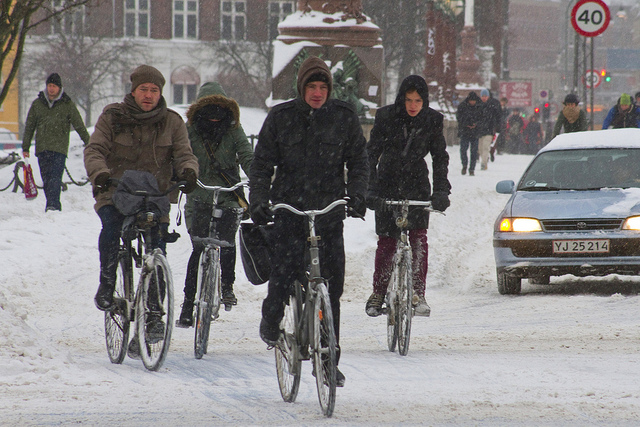Last winter was a strange one for Seattlites. Sometimes the bike routes looked like this, but other times, they looked like this. Snowy and in the 30s one week, then sunny and in the 50s another---I'm new to the city but even I can tell this season has been odd. But do you know what's not odd? Riding your bike in winter. In fact, getting around town by bike in winter is as ordinary as riding your bike the rest of the year.
A post from the Cophenhagenize blog critiques the cycling world's overcomplication of winter biking and reminds readers that winter cycling in Copenhagen is mainstream because it is presented as simple and ordinary, not sub-cultural. The author describes what he sees as flawed approach to encouraging winter bicycling among the masses; winter bicycle guides should emphasize getting from point A to point B by bike (as people do the rest of the year) rather than laundry lists of recommended clothes and gear.

In Copenhagen, winter bike commuting is perceived as more ordinary than in Seattle and is therefore more popular, despite Denmark's slightly harsher climate. (Image: by Mikael Colville-Andersen on Flickr, via Copenhagenize)
Every year, the bicycling blogosphere becomes saturated with winter biking how-to guides, which--as practical as they may be--sometimes give off the wrong image of winter bicycling to the general public and novices. The guides recommend that interested cyclists invest hundreds of dollars on special winter clothes, studded tires, and a host of other accoutrements before even contemplating winter biking. Readers may infer from these guides that winter biking is only for 'hardcore' cyclists; winter biking is too risky and dangerous for the majority of people.
But is that true? Is bike commuting exclusively for the spandex racing types, macho daredevils, and unofficial members of cycling subculture? The short answer: no. As a year-round bike commuter of limited means from upper midwest who --for better or for worse--owns basically no cycling-specific accessories (except a helmet!), I can confidently say that if you own a winter/rain wardrobe (most people already do), a can-do attitude (most cyclists already do), and a sense of caution (most smart cyclists already do), you can get around town on your bike in winter. Investments in snow tires and special accessories are great if you have the disposable income and may increase your feelings of safety and comfort, but they are not necessary.

Aspiring winter bikers need not develop personal snow plows, though that is pretty creative. (Image: Carfree American)
Disclaimer: I am not suggesting that novices immediately try to tackle icy, hilly streets during rush hour traffic at first opportunity. It's true that the risks associated with winter biking are higher and mental preparation for road conditions is a necessity (just as in the rain or fog), but the benefits of winter biking (physical, emotional, environmental) outweigh most barriers. As with any change to your routine, start slow. Exercise extra caution on the streets, know your limits, dress for the weather, and--just as with a car--expect to move more slowly and more carefully on hazardous road conditions. Many winter cycling how-to guides contain useful safetyand comfort tips and are worth the read, but do not be scared away by their long lists of expensive requirements.
The [winter] bicycling revolution doesn't happen [only] in spandex and cycle shoes; it happens in jeans, suits, sneakers, and--depending on the weather--a cap and mittens.
PS: Speaking of revolutions, when are these 'cycle-skates' coming back? I realize these are pre-cursors to roller-blades, but I feel they have a place somewhere in the 21st century (perhaps the bike polo court at Cal Anderson Park?)
Share this post
